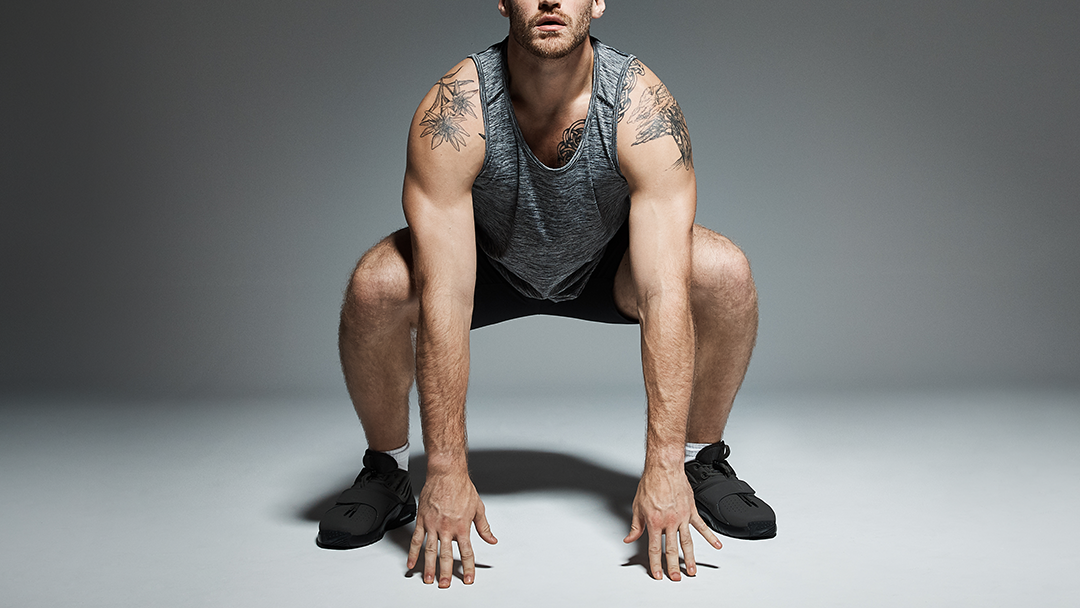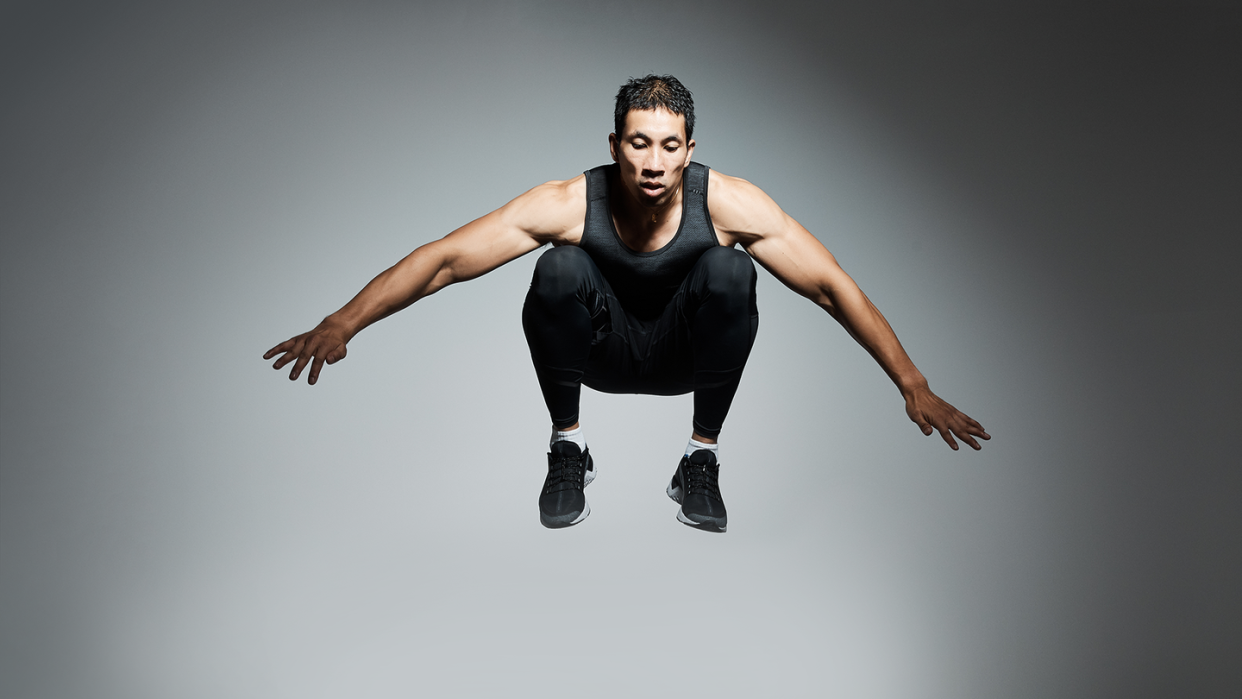How to Do the Best Burpees Possible
FOR MOST GYM-GOERS, there's one word that serves as a shorthand for painful, difficult workouts that will likely leave them doubled-over and heaving to catch their breath: burpee.
The burpee is one of the most infamous exercises in fitness, a heart rate-raising maneuver that some trainers swear by and others avoid like the plague. The bodyweight movement is simple, but doing it the right way can present more of a challenge than you might expect. There's much more to the burpee than just throwing yourself down on the floor and popping back up to your feet.
This is the type of move that you need to understand before you put yourself in a situation where you might be asked to perform reps at volume, like a group fitness class or a similar workout setup. There are some coaches and trainers who do know how to mete out burpee reps responsibly—but there's a much greater number who are more inclined to put you in harm's way with mindless sets without a second thought.
Take a moment to learn the subtleties of the movement from MH fitness director Ebenezer Samuel, C.S.C.S. and senior editor Brett Williams, NASM so you won't find yourself in a world of pain.
How the Burpee Was Created
The movement itself, a brutally efficient bodyweight exercise that demands you to get down on the ground, then back up again as quickly as physically possible, has taken on an outsized reputation as a grueling conditioning tool used in everything from CrossFit WODs to group fitness classes. That's slightly surprising given its origin—the exercise was named after its creator, physiologist Royal H. Burpee, as a protocol to test fitness and physical capacity. Later on, burpees were used by the US military as a benchmark test for incoming recruits.
Now, the burpee has taken on an outsized reputation as one of the toughest moves you can include into your workout, in part because of the deviations from its creator's original template. Most common burpee variants consist of a jump and pushup, a much more active exercise than the four-part standard laid down in the late 1930s that didn't include those two powerful movements.
Benefits of Burpees
Trainers like including burpees in their workouts because the movement is a surefire method to raise the heart rate. This can be an effective conditioning tool for athletes. All of this activity makes the exercise a major calorie-burner, too. Finally, this is a multi-joint, multi-step movement, and if you're performing it properly you'll hone body control and coordination and express explosiveness and power, too.
Downsides of Burpees
Most people think of burpees as a high-capacity conditioning drill instead of the fitness test it was developed to be, one that exercisers perform for a long string of reps in order to ramp up the heart rate and cause exhaustion. The more explosive elements have also helped to make the burpee controversial among some fitness pros, who contend that the burpee is often programmed dangerously—or that it is an inherently dangerous movement—especially for beginners.
The issue many trainers have with burpees stems from breakdowns in form and intent. If the exerciser isn't experienced or if they're too tired from the accumulation of reps, they might be at risk of injuring their wrists or elbows if they're not able to control the way they hit the ground during the first part of the movement, which can become especially dangerous if there's a time-cap to the workout.
If a trainer teaches the burpee as an exercise that is more focused on throwing oneself on the ground and getting up again as quickly as possible instead of a multiple-part maneuver, there's even more risk. Avoid these workouts if you find yourself working with such a trainer.
How to Do Burpees Safely

Start standing with your feet shoulder-width apart.
Squat down, placing your hands flat on the floor inside your feet.
Leap your feet back into a pushup position, squeezing your shoulder blades, abs, and glutes. Your feet should be slightly wider than shoulder-width apart.
Bend at the elbows to lower your chest down to the floor. Control this movement rather than throwing yourself straight down.
Press back up into the pushup.
Leap your feet forward back to the initial squatting position.
Explode straight up into the air powerfully, with triple extension through the ankle, knee, and hip.
Land back on the floor under control.
Use this extra insight from Samuel to inform your reps.
Jump Efficiently
Eb says: When you're doing burpees, think of getting off the ground as "efficiently" as possible. Note that I didn't say "quickly." If you focus only on quickness, but you're not hitting efficient positions, you're going to leak and waste energy. By default, you won't get up as quickly as you want to. And if you're wasting a ton of energy on each rep, it'll slow you down and fatigue you faster as you pile up reps and work time.
Hit the Ground Strong
Eb says: Never be a jellyfish on the ground when doing burpees. Remember that that straight-body position, which you hit once when you put your hands and feet on the ground and then again when you lower your chest to the ground from there, is meant to be a plank. That means your abs are fired up and your glutes are contracted. You'll be much faster through both phases if you keep your core fired up, and you'll be protecting your spine and staving off any lower back injuries, too.
Keep a Wide Base
Eb says: Always think "feet wide" when doing burpees—as in, at least shoulder-width apart at all times. Essentially, you want your feet constantly at a width from which you can jump. So when you lower your torso to the ground, and you're in that plank, they're wide. When you leap your feet back towards your hands, they're wide, too. Do this, and when it's time to jump, you won't have to waste any time getting into optimal position to jump -- because you're already there.
Own Your Jump
Eb says: Own the jump on the burpee. That doesn't necessarily mean jumping sky-high, but it does mean really jumping (as opposed to the bunny hops I see too many people doing. Explode from your ankles, knees, and hips on every jump. A burpee is a valuable opportunity to train triple extension (the same thing that athletes train, and the same thing you train when you're doing a power clean), so don't waste that in the quest to do zounds of reps faster than everyone else.

How to Include Burpees in Your Workouts
Don't fall prey to the temptation of performing burpees as fast as you possibly can until you drop or for minutes on end. Instead, be smart with this conditioning tool. Think about perfect form on every rep. Start with 3 to 4 rounds of 20 seconds on, 40 seconds off.
6 Killer Burpee Variations
Once you master the basic form, try these variations for another challenge.
Tuck Jump Burpee
Why: This variation is all about the jump.
How to Do It:
Start as you would for a standard burpee—squat down with your hands on the ground inside your feet, kick back into a pushup position with your feet wide and hit the deck.
Then leap your feet forward, but focus even more on exploding upwards out of the hole than you typically would in a normal rep.
As you leap, bend your knees and bring them to your chest, tucking at the top, before extending your legs to land safely.
Hand Release Burpee
Why: You’ll slow down and focus more on your time on the floor with this variation—which can be a great tendency-breaker if you’re rushing through your standard reps. You’ll also add some back work to the burpee, engaging lats and rhomboids when you lift your hands off the ground and squeeze your shoulder blades. If there’s a criticism with the burpee, it’s that the move can batter your shoulders, but the hand-release moment helps offset that.
How to Do It:
Move through the first steps of the standard burpee, but pause once your chest hits the deck.
Raise both hands off the floor for a full beat.
Press back down into the floor to raise up through the jump.
Burpee to Jump Lunge
Why: Swap out the pure explosiveness of the standard burpee for a more controlled jump lunge. You'll get a unilateral challenge and add an extra step for more movement.
How to Do It:
Perform a standard burpee rep.
Once you’re back on your feet, hop and cycle one leg forward, the other back, allowing your knee to lightly tap the ground (for your own sake, avoid slamming the floor).
Immediately jump and switch your legs to the opposite side and repeat.
Single-Leg Burpee
Why: This one is a toughie, and an even more difficult unilateral challenge.
How to Do It:
Do all the same steps as the standard burpee. You’ll do the entire exercise on one leg, challenging your balance and unilateral strength.
Understandably, you might not squat as low as you would in a standard rep to get into position.
Make sure to move more slowly and deliberately here to stay steady on that one foot and focus on control; don’t let your knee cave inwards at any point.
Burpee Switch
Why: The Switch will put your coordination to the test, especially when you string several reps together in a set.
How to Do It:
Go through all of the movements of the standard burpee, up until the jump.
Instead of jumping straight up, jump to turn around 180 degrees, then land cleanly facing the other side.
Jump straight back to face the front.
Lateral Jump Burpee
Why: You’ll need even more floor space to take on this variation, but you’ll be doing something people don’t do often enough and incorporating lateral work into your training.
How to Do It:
Perform a standard rep, until you get to the jump.
Instead of leaping upwards, spring laterally to the side.
Immediately squat down into the next rep—but then, instead of using your jumps to travel even further around your gym, leap back to the starting spot.
Want to master even more moves? Check out our entire Form Check series.
You Might Also Like
